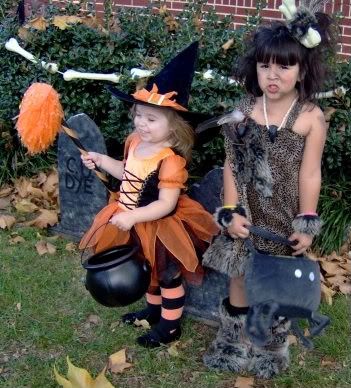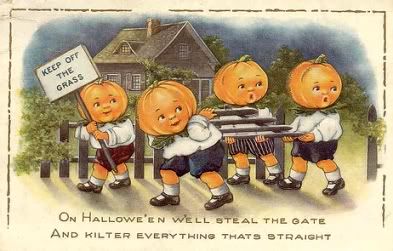
Trick or treating as we know it today is a blend of several ancient and modern influences.
In ancient Celtic times (Ireland somewhere around 800 B.C.) the children in Celtic society would walk door to door to collect firewood for a giant communal bonfire which was the main event of their Samhain celebration. Once the bonfire was burning, they would extinguish all the other fires in the village then relight every fire with a flame taken from the Samhain bonfire, as a symbol of their connection to on another.
In 9th century europe, a popular All Soul's Day practice was to make 'Soul Cakes', which were simply a bread dessert with a current topping. Much like our trick or treating today, people would walk from village to village offering prayers for the dead in return for gifts of food in a practice that was called 'Souling'. The prayers were said to help the person's relatives find their way out of purgatory and into heaven.
In other medieval times, in places such as Ireland and the British Isles, costumed adults and older teens would go from house to house demanding beer and food items in exchange for small performances.
In 1930's America, adults began looking for ways to control the increasingly dangerous and expensive vandalism which happened on Halloween, so they began giving out bribes to the kids to distract them from the mischief. The term 'trick or treat" finally appears in print around 1939.
With typically more than 85% of U.S. households handing out candy on Halloween night, All Hallows Eve is the number one holiday for candy sales according to the National Confectioners Association, beating out Christmas, Easter and Valentines Day.

Who would have thought that the fun loving-sometimes vicious-pranks that happen each Halloween would have roots that date all the way back to around 800 B.C. in Ireland?
Like all early societies, the Celts were very structured and organized-but during Samhain celebrations, which lasted from October 31st to November 2nd, order and structure were thrown out the window and chaos reigned. People would do crazy things such as moving people's horses to different fields and they also unhinged farmers gates and left them in ditches.
In 19th century America, rural immigrants from Ireland and Scotland brought Halloween customs from from their homelands and one of those traditions was that on Halloween night, the boys would roam the outdoors engaging in almost ritualized pranks. At that time, the favorite pranks in New England included tipping over outhouses and unhinging fence gates. The next day, the pranks were blamed on unruly spirits.
In 1930's America, when pranks got increasingly more expensive and dangerous, householders began giving out bribes to the neighborhood kids as a way to distract them away from their previous anarchy.
Hope you enjoyed this Halloween History lesson!

(Note: The two little trick-or-treaters are my bewitching little girl Zoey and my cave girl niece Lexi.)












No comments:
Post a Comment